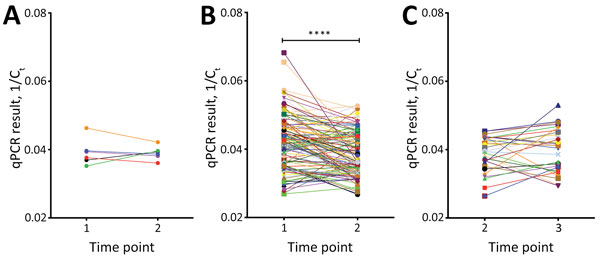Volume 24, Number 8—August 2018
CME ACTIVITY - Research
Ancylostoma ceylanicum Hookworm in Myanmar Refugees, Thailand, 2012–2015
Figure 4

Figure 4. Change in relative quantities of Ancylostoma ceylanicum and Necator americanus hookworm genomic DNA in fecal samples from US-bound Myanmar refugees at 3 camps along the Myanmar–Thailand border after treatments with albendazole and ivermectin, Thailand, 2012–2015. Fecal samples were collected at 3 time points: time point 1 (T1, baseline), time point 2 (T2, after first treatment), and time point 3 (T3, after second treatment). Quantities were expressed as 1/Ct and differences were assessed by paired t-test. A) A. ceylanicum genomic DNA relative quantities in those who were persistently infected after first treatment (n = 6). The difference between T1 and T2 was not significant. B) N. americanus genomic DNA relative quantities in those who were persistently infected after first treatment (n = 122). The relative genomic DNA quantity was significantly reduced in those who remained infected with N. americanus hookworm after first treatment. C) N. americanus genomic DNA relative quantities in those who were persistently infected after second treatment (n = 29). No significant change in N. americanus relative quantity was found in those persistently infected after the second treatment. The geometric mean time from T1 to T2 was 188.2 (range 48–1,013) d and from T2 to T3 was 46.2 (range 14–413) d. ****p<0.0001. Ct, cycle threshold; qPCR, quantitative PCR.
1These authors contributed equally to this article